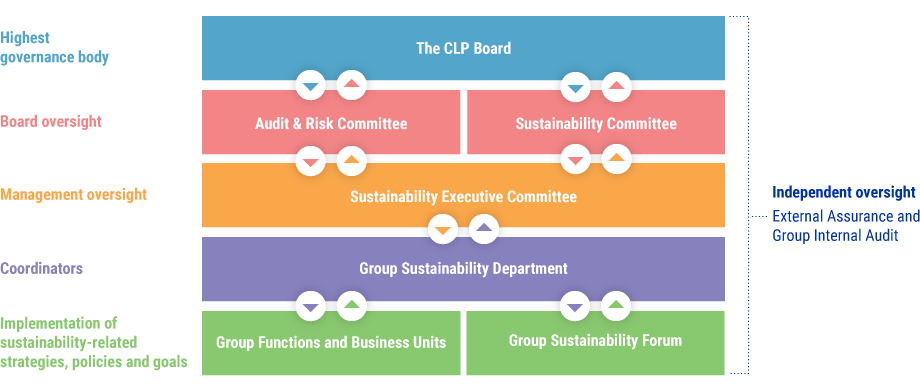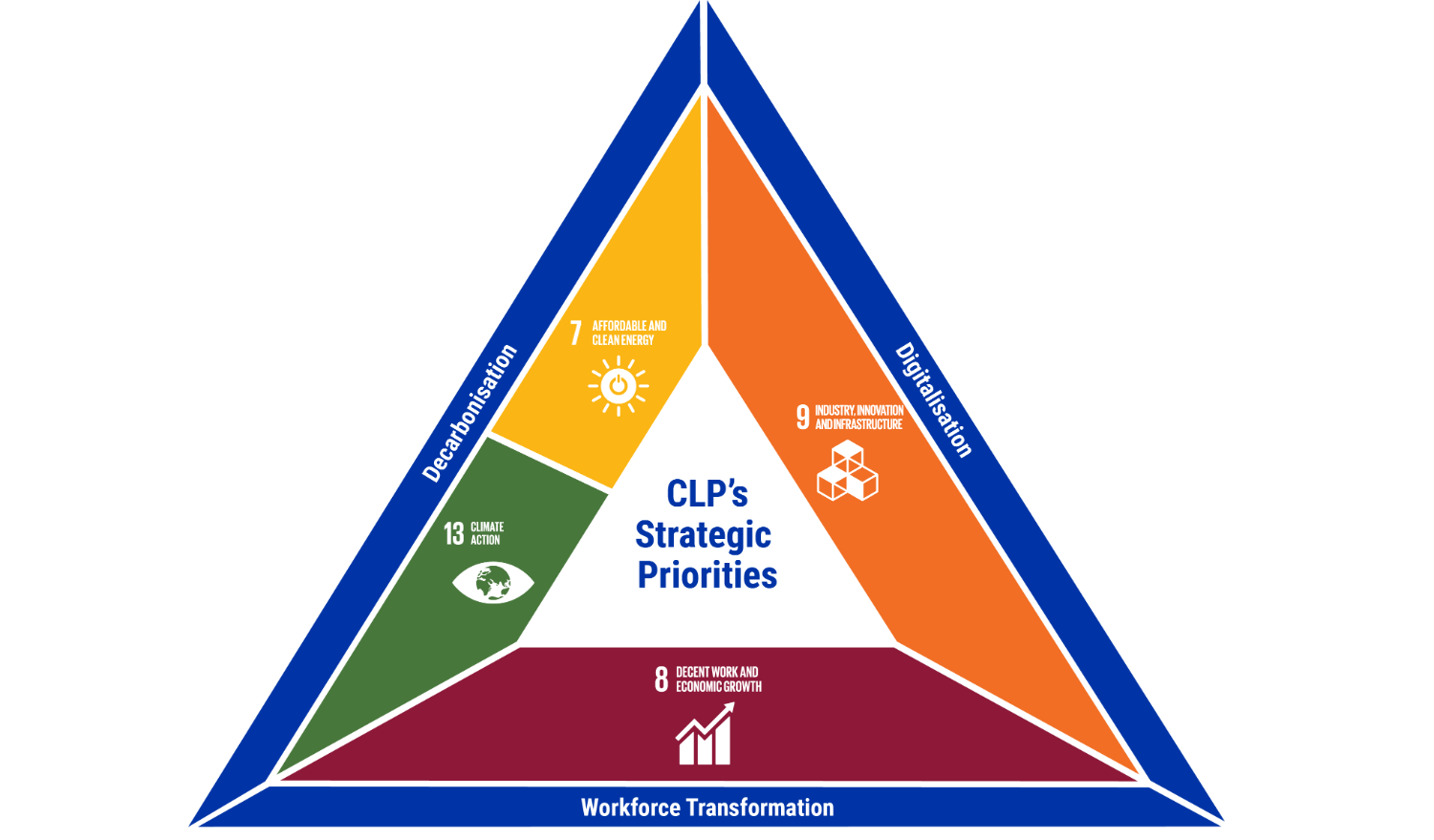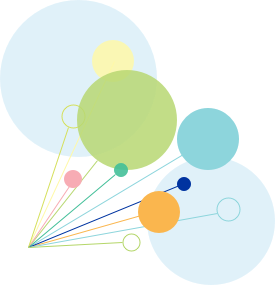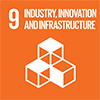Sustainability governance overview Copy linkCopied link
A strong governance framework is key to ensuring that the sustainability issues that CLP faces are incorporated into the corporate agenda.
The CLP Board has overall responsibility for CLP’s environmental, social and governance (ESG) strategy and reporting.
As shown in the diagram below, the governance of sustainability is integrated into the corporate governance structure. Two of the Board Committees, the Sustainability Committee and the Audit & Risk Committee, have separate but complementary roles in ESG management.

Board oversight Copy linkCopied link
For CLP Group, sustainability governance has been embedded in the corporate governance structure – from Board-level committees to management-level Group functions and business units.
As one of the Board Committees, the Sustainability Committee has a primary role in overseeing the management of the Group’s sustainability issues and is supported by the Sustainability Executive Committee. The Audit & Risk Committee retains oversight and responsibility for material risks, as well as ensures the assurance of the sustainability data is appropriate.
Read about our Corporate GovernanceIn 2020, the Sustainability Committee as well as the Board spent significant time in considering the longer term issues impacting CLP, with particular focus on:
Innovation and digitalisation – Management provided an overview of the impact of digitalisation and the associated changing competitive landscape along with a review of the actions being taken and investments made by CLP in this area. Potential business opportunities in the areas of energy-related services and the critical success factors for developing data centres were discussed.
Climate change and Climate Vision 2050 – The Sustainability Committee had the benefit of a briefing from a leading external expert on climate change which included a comprehensive update on developments in climate change and provided the Committee an external perspective on how CLP was performing and progressing on climate action. The expert session was complemented by management’s briefing on the broader climate action landscape and the Committee and management had an open dialogue on the directional approach that CLP should be taking in line with the Climate Vision 2050 and the updating of CLP’s decarbonisation targets.
The Committee’s objective is to oversee management and advise the Board on matters required to enable:
The CLP Group to operate on a sustainable basis for the benefit of current and future generations;
Sustainable growth by maintaining and enhancing CLP Group’s economic, environmental, human, technological and social capital in the long term; and
The effective management of CLP Group’s sustainability risks.
A key focus of the Committee's work this year was in overseeing the longer-term emerging sustainability issues and the impact on the Group's strategy. The Committee had extended meetings with dedicated deep dive sessions on Innovation and Digitalisation as well as on Climate Change.
Terms of Reference of the Sustainability Committee
Between 1 January 2020 and the date of this report, the Committee met four times (including three times in 2020 and once in 2021). Below is a summary of how the Committee spent its time during this period.
Looking ahead, the Committee will continue its focus on longer-term emerging sustainability issues concerning the Group. Following on from its deep dive session on Climate Change in 2020, the Committee is well positioned as the Group prepares for a review of the targets set out in the Climate Vision 2050. In addition, the pandemic has brought a sharp focus on ESG issues and the Committee, with the support of management, will need to stay closely attuned to the evolving issues of ESG and sustainability.
Overview of work conducted by the Sustainability Committee in 2020 and up to the date of this Report
2020 | 2021 | |||
|---|---|---|---|---|
February | October | November | February | |
Sustainability matters – risks, opportunities and emerging issues |  |  | ||
Sustainability reporting / Indices performance |  |  |  |  |
Health, Safety, Security and Environment |  | |||
Community, charitable and environmental partnerships and initiatives |  |  | ||
Risks are managed at both the strategic and operational levels to support the long-term sustainability of growth objectives, while at the same time supporting the operational needs of the current business.
In relation to sustainability issues, the ARC is responsible for ensuring the data in the Sustainability Report is appropriate. Independent oversight is maintained through robust internal control systems, and assurance of the accuracy of metrics and reporting that follows appropriate accounting principles and reporting practices. CLP’s independent auditor is also responsible for assuring key ESG data, and their findings and observations are presented to senior management and the Board through the ARC.
Read the full report on the ARC’s activities in this period Management roles Copy linkCopied link
The SEC is chaired by the Chief Executive Officer (CEO) as part of the role’s executive-level responsibility for economic, environmental and social matters. Set up in 2016, it comprises the corporate senior management team of:
Mr Richard Lancaster (CEO), Chairman, also Chairman of the Sustainability Committee;
Ms Quince Chong (Chief Corporate Development Officer), also a member of the Sustainability Committee;
Mr Geert Peeters (Chief Financial Officer (CFO));
Mr Nicolas Tissot (Deputy Chief Financial Officer), who was appointed in September 2020;
Mr David Smales (Chief Operating Officer);
Mr David Simmonds (Group General Counsel & Chief Administrative Officer); and
Ms Eileen Burnett-Kant (Chief Human Resources Officer).
The SEC steers the sustainability strategy of the Group and approves relevant deliverables. The CEO and CFO also hold management responsibilities for the assurance of ESG data, and jointly sign off the General Representation Letter connected with the assurance process.
In 2020, the Committee convened six times, including before each Sustainability Committee meeting. These meetings provide a platform for the executive team to initiate or develop strategic sustainability projects, shape and receive progress updates on current projects and to engage in strategic discussions on emerging issues.
Five of the meetings in 2020 reviewed and advised on strategic sustainability projects, and the other was a special topic workshop to deep dive into emerging issues. The meetings are facilitated by the CLP’s Director – Group Sustainability.
Key themes discussed in 2020 included:
Climate Vision 2050 and the Group’s strategy in decarbonisation, and the roadmap for strengthening climate change-related targets;
Climate change-related risks and opportunities, and CLP’s response to the TCFD recommendations, including the development of climate scenarios for further analysis;
Enhancement of labour practices amongst the workforce and supply chain;
Preparation and review of the CLP Value Framework;
Performance on key sustainability indices and how benchmarking results can drive improvements in operational performance;
The Group's response to ESG-related public consultations;
Enhancement of the Group’s ESG data management and reporting; and
Preparation and development of the Sustainability Report, including materiality assessment, reporting standards and the assurance of key metrics.
The department aims to embed sustainability into existing practices by informing the development of the business strategy and planning processes. It monitors sustainability issues and updates the Sustainability Committee and SEC on emerging risks and opportunities. It also leads corporate sustainability reporting and facilitates in identifying areas for improving operational performance.
The department, meanwhile, manages the Group’s climate change strategy. It includes reporting and reviewing progress on its Climate Vision 2050 and TCFD implementation, as well as monitoring changes in stakeholder expectations and their implications to the Company.
Furthermore, the Group Sustainability Department is committed to developing capacity on ESG reporting and performance management as well as exchanging experience across organisations, sectors and countries. It supports and organises sustainability-related events and works closely with different stakeholder groups. For instance, the department facilitates various Group functions and business units across regions to meet regularly on a forum call and share experience and insights on how to move sustainability forward.
Alignment with the Sustainable Development Goals Copy linkCopied link
CLP has prioritised four of the 17 Sustainable Development Goals (SDGs) considered most relevant, and where the Group can make a significant impact.
Following the announcement of the United Nations SDGs in 2015, CLP developed its set of Sustainability Principles to guide the Group’s activities and better align business objectives with value creation. It has also prioritised four of the 17 SDGs that are considered as most relevant to the business and where CLP is expected to make the biggest impact.
The four SDGs prioritised by the Group are:
Climate Action (SDG13)
Affordable & Clean Energy (SDG7)
Decent Work & Economic Growth (SDG8), and
Industry, Innovation & Infrastructure (SDG9).
Their relationship with CLP's business strategy is outlined in the diagram below:
In the latest review of the CLP Value Framework, the Sustainability Principles were fully integrated into CLP’s Values and Commitments to underscore how integral sustainability is to the Group's long-term development. Along with the prioritised SDGs, CLP’s Value Framework sets a foundation for articulating the Group’s sustainability priorities in support of its longer-term business strategy.
In 2019, CLP joined the World Business Council for Sustainable Development SDG Sector Roadmap Working Group for electric utilities. This project aims to establish the priority SDGs for the sector, identify key opportunities to contribute to the SDGs, and encourage stakeholders in the sector to take collective actions for greater impact. CLP’s priority SDGs are in line with the preliminary recommendations from the Working Group. Further information will be available in the final report, which is expected to be released in mid-2021.






